Sustainable Tourism: Concept, Application, and Impact Report
VerifiedAdded on 2023/01/11
|16
|5472
|41
Report
AI Summary
This report is a comprehensive analysis of sustainable tourism, encompassing its core concepts, principles, and practical applications. Part 1 provides an essay defining sustainable tourism and its evolution, highlighting the roles of organizations like the WTO and WTTC. Part 2 is a management report outlining the principles and processes of tourism development and planning, emphasizing resource utilization, cultural preservation, and economic viability. Part 3 offers an individual report focusing on the economic, social, and cultural impacts of tourism on the Great Barrier Reef. Finally, Part 4 is a management report evaluating sustainable tourism management and development strategies. The report underscores the importance of balancing the needs of tourists, the tourism industry, and host communities while minimizing negative environmental and social impacts. It also discusses the role of global organizations in promoting sustainable practices, and the process and approaches of tourism planning. The report emphasizes the need for long-term, sustainable economic operations within the tourism industry to mitigate seasonal variations and ensure consistent benefits for all stakeholders.

Sustainability and
Responsible Tourism Concept
& Application
Responsible Tourism Concept
& Application
Paraphrase This Document
Need a fresh take? Get an instant paraphrase of this document with our AI Paraphraser
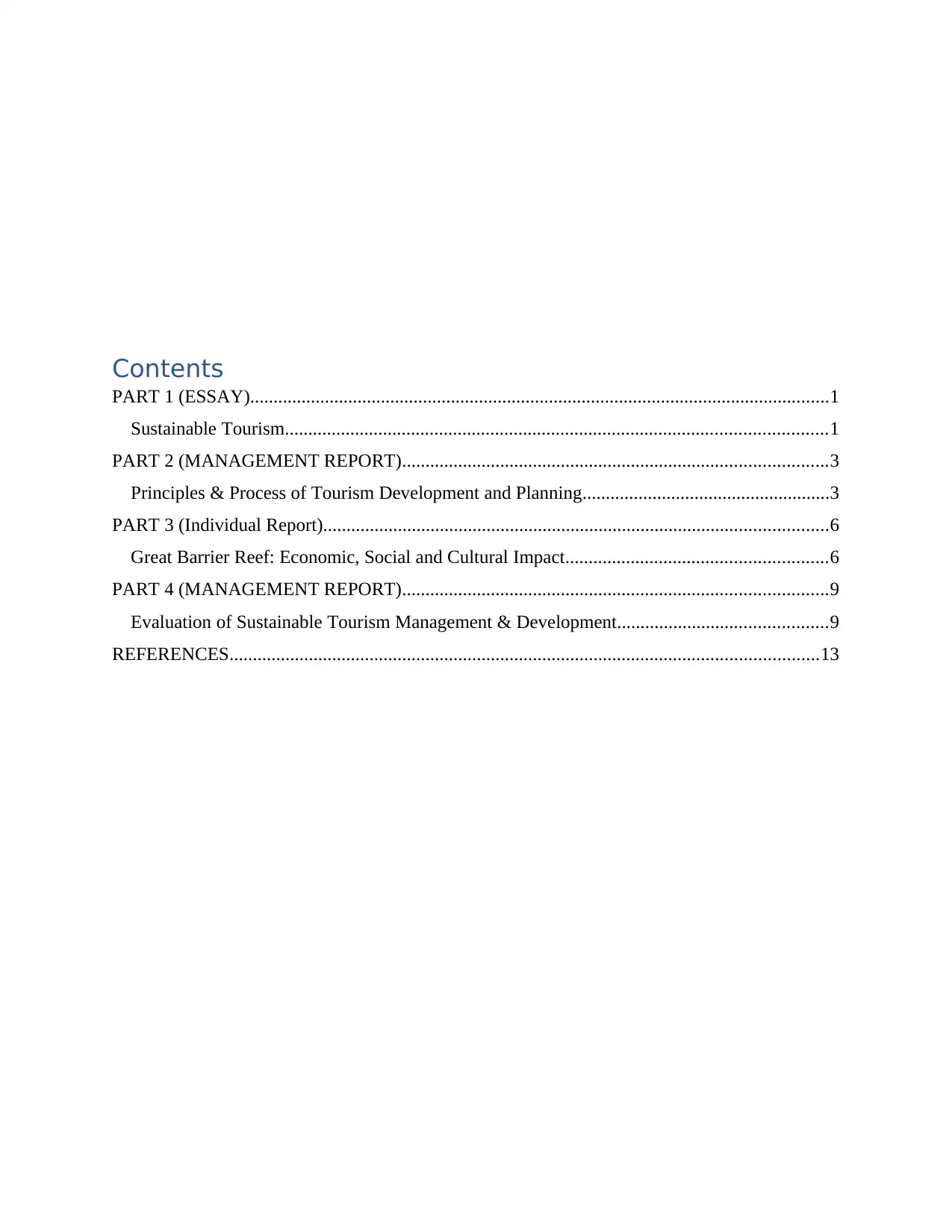
Contents
PART 1 (ESSAY)............................................................................................................................1
Sustainable Tourism....................................................................................................................1
PART 2 (MANAGEMENT REPORT)...........................................................................................3
Principles & Process of Tourism Development and Planning.....................................................3
PART 3 (Individual Report)............................................................................................................6
Great Barrier Reef: Economic, Social and Cultural Impact........................................................6
PART 4 (MANAGEMENT REPORT)...........................................................................................9
Evaluation of Sustainable Tourism Management & Development.............................................9
REFERENCES..............................................................................................................................13
PART 1 (ESSAY)............................................................................................................................1
Sustainable Tourism....................................................................................................................1
PART 2 (MANAGEMENT REPORT)...........................................................................................3
Principles & Process of Tourism Development and Planning.....................................................3
PART 3 (Individual Report)............................................................................................................6
Great Barrier Reef: Economic, Social and Cultural Impact........................................................6
PART 4 (MANAGEMENT REPORT)...........................................................................................9
Evaluation of Sustainable Tourism Management & Development.............................................9
REFERENCES..............................................................................................................................13

⊘ This is a preview!⊘
Do you want full access?
Subscribe today to unlock all pages.

Trusted by 1+ million students worldwide
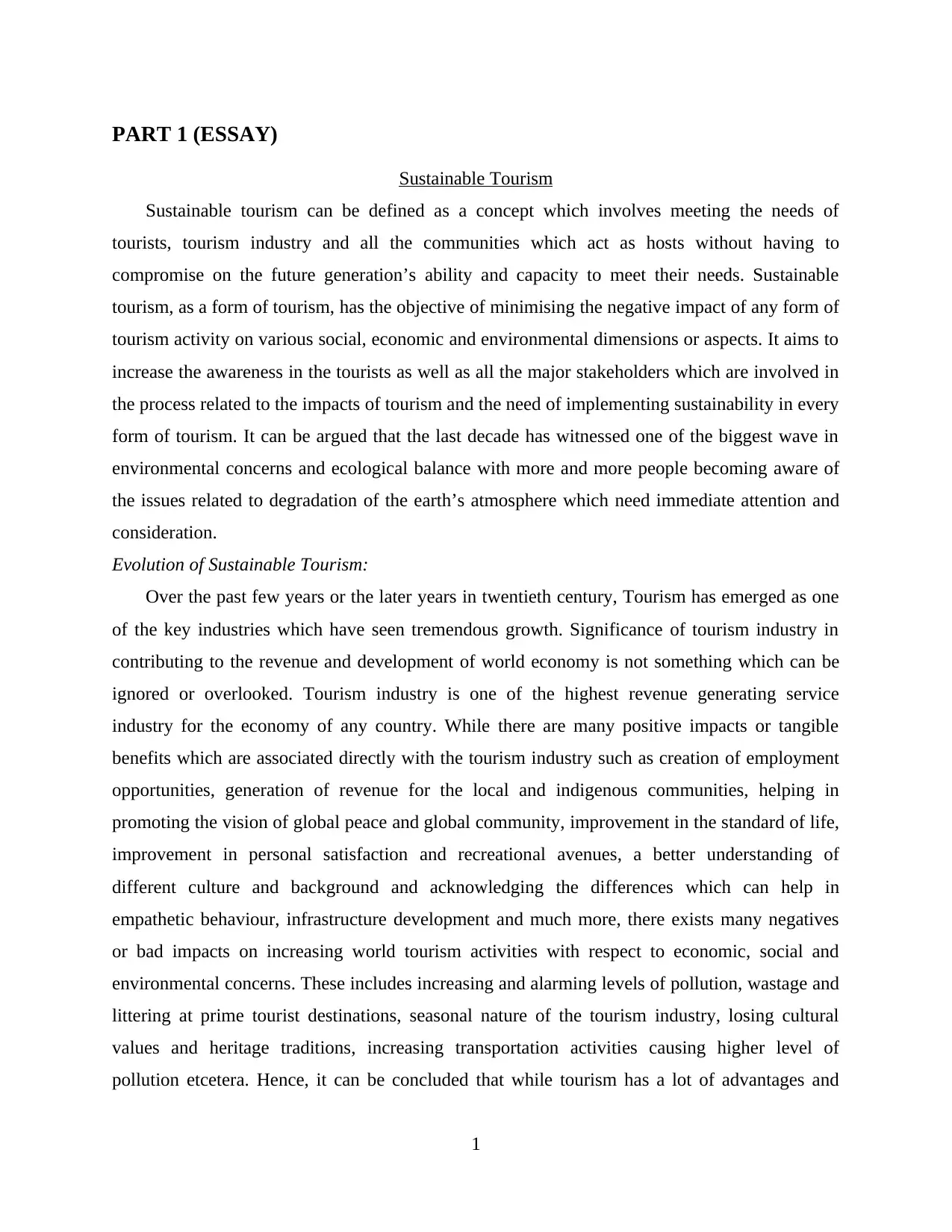
PART 1 (ESSAY)
Sustainable Tourism
Sustainable tourism can be defined as a concept which involves meeting the needs of
tourists, tourism industry and all the communities which act as hosts without having to
compromise on the future generation’s ability and capacity to meet their needs. Sustainable
tourism, as a form of tourism, has the objective of minimising the negative impact of any form of
tourism activity on various social, economic and environmental dimensions or aspects. It aims to
increase the awareness in the tourists as well as all the major stakeholders which are involved in
the process related to the impacts of tourism and the need of implementing sustainability in every
form of tourism. It can be argued that the last decade has witnessed one of the biggest wave in
environmental concerns and ecological balance with more and more people becoming aware of
the issues related to degradation of the earth’s atmosphere which need immediate attention and
consideration.
Evolution of Sustainable Tourism:
Over the past few years or the later years in twentieth century, Tourism has emerged as one
of the key industries which have seen tremendous growth. Significance of tourism industry in
contributing to the revenue and development of world economy is not something which can be
ignored or overlooked. Tourism industry is one of the highest revenue generating service
industry for the economy of any country. While there are many positive impacts or tangible
benefits which are associated directly with the tourism industry such as creation of employment
opportunities, generation of revenue for the local and indigenous communities, helping in
promoting the vision of global peace and global community, improvement in the standard of life,
improvement in personal satisfaction and recreational avenues, a better understanding of
different culture and background and acknowledging the differences which can help in
empathetic behaviour, infrastructure development and much more, there exists many negatives
or bad impacts on increasing world tourism activities with respect to economic, social and
environmental concerns. These includes increasing and alarming levels of pollution, wastage and
littering at prime tourist destinations, seasonal nature of the tourism industry, losing cultural
values and heritage traditions, increasing transportation activities causing higher level of
pollution etcetera. Hence, it can be concluded that while tourism has a lot of advantages and
1
Sustainable Tourism
Sustainable tourism can be defined as a concept which involves meeting the needs of
tourists, tourism industry and all the communities which act as hosts without having to
compromise on the future generation’s ability and capacity to meet their needs. Sustainable
tourism, as a form of tourism, has the objective of minimising the negative impact of any form of
tourism activity on various social, economic and environmental dimensions or aspects. It aims to
increase the awareness in the tourists as well as all the major stakeholders which are involved in
the process related to the impacts of tourism and the need of implementing sustainability in every
form of tourism. It can be argued that the last decade has witnessed one of the biggest wave in
environmental concerns and ecological balance with more and more people becoming aware of
the issues related to degradation of the earth’s atmosphere which need immediate attention and
consideration.
Evolution of Sustainable Tourism:
Over the past few years or the later years in twentieth century, Tourism has emerged as one
of the key industries which have seen tremendous growth. Significance of tourism industry in
contributing to the revenue and development of world economy is not something which can be
ignored or overlooked. Tourism industry is one of the highest revenue generating service
industry for the economy of any country. While there are many positive impacts or tangible
benefits which are associated directly with the tourism industry such as creation of employment
opportunities, generation of revenue for the local and indigenous communities, helping in
promoting the vision of global peace and global community, improvement in the standard of life,
improvement in personal satisfaction and recreational avenues, a better understanding of
different culture and background and acknowledging the differences which can help in
empathetic behaviour, infrastructure development and much more, there exists many negatives
or bad impacts on increasing world tourism activities with respect to economic, social and
environmental concerns. These includes increasing and alarming levels of pollution, wastage and
littering at prime tourist destinations, seasonal nature of the tourism industry, losing cultural
values and heritage traditions, increasing transportation activities causing higher level of
pollution etcetera. Hence, it can be concluded that while tourism has a lot of advantages and
1
Paraphrase This Document
Need a fresh take? Get an instant paraphrase of this document with our AI Paraphraser
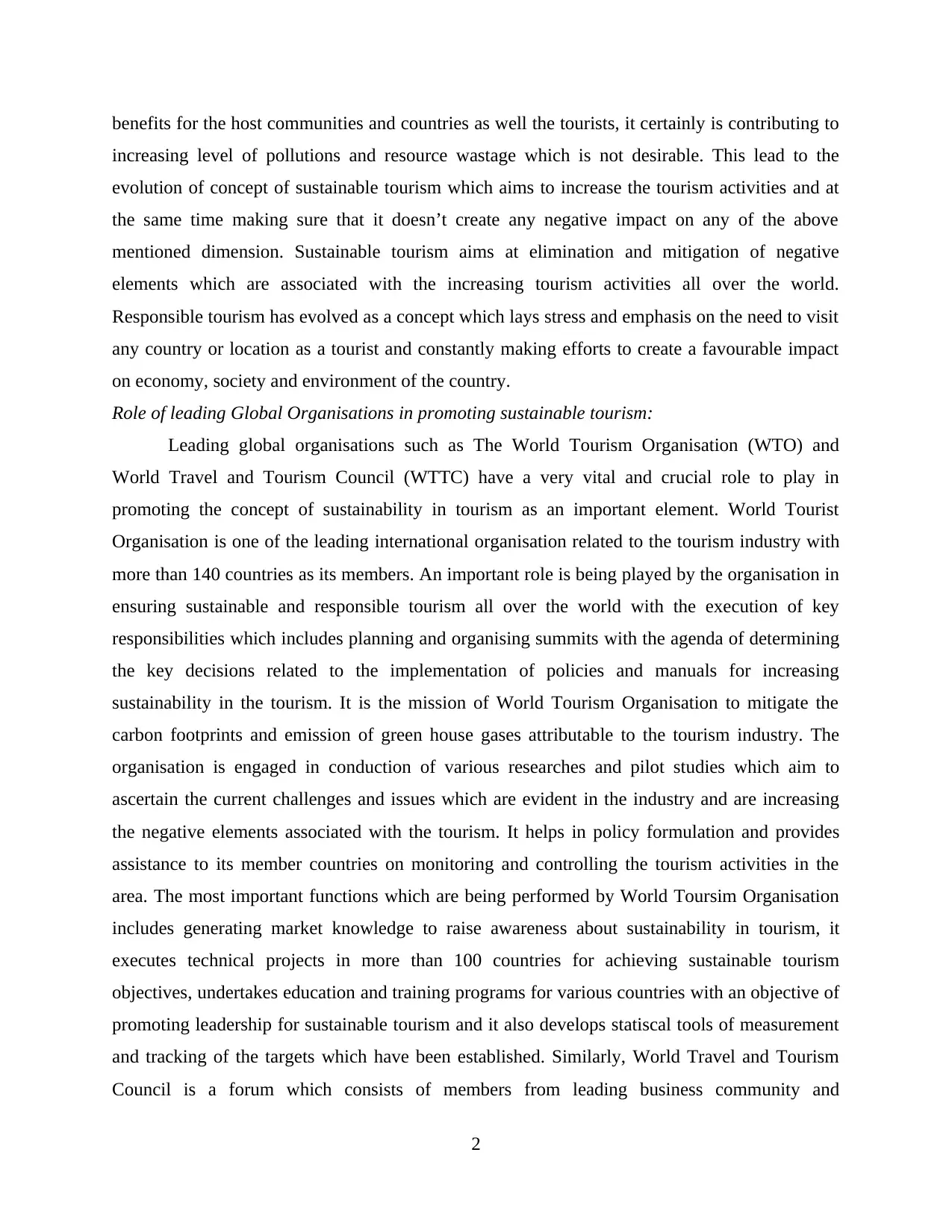
benefits for the host communities and countries as well the tourists, it certainly is contributing to
increasing level of pollutions and resource wastage which is not desirable. This lead to the
evolution of concept of sustainable tourism which aims to increase the tourism activities and at
the same time making sure that it doesn’t create any negative impact on any of the above
mentioned dimension. Sustainable tourism aims at elimination and mitigation of negative
elements which are associated with the increasing tourism activities all over the world.
Responsible tourism has evolved as a concept which lays stress and emphasis on the need to visit
any country or location as a tourist and constantly making efforts to create a favourable impact
on economy, society and environment of the country.
Role of leading Global Organisations in promoting sustainable tourism:
Leading global organisations such as The World Tourism Organisation (WTO) and
World Travel and Tourism Council (WTTC) have a very vital and crucial role to play in
promoting the concept of sustainability in tourism as an important element. World Tourist
Organisation is one of the leading international organisation related to the tourism industry with
more than 140 countries as its members. An important role is being played by the organisation in
ensuring sustainable and responsible tourism all over the world with the execution of key
responsibilities which includes planning and organising summits with the agenda of determining
the key decisions related to the implementation of policies and manuals for increasing
sustainability in the tourism. It is the mission of World Tourism Organisation to mitigate the
carbon footprints and emission of green house gases attributable to the tourism industry. The
organisation is engaged in conduction of various researches and pilot studies which aim to
ascertain the current challenges and issues which are evident in the industry and are increasing
the negative elements associated with the tourism. It helps in policy formulation and provides
assistance to its member countries on monitoring and controlling the tourism activities in the
area. The most important functions which are being performed by World Toursim Organisation
includes generating market knowledge to raise awareness about sustainability in tourism, it
executes technical projects in more than 100 countries for achieving sustainable tourism
objectives, undertakes education and training programs for various countries with an objective of
promoting leadership for sustainable tourism and it also develops statiscal tools of measurement
and tracking of the targets which have been established. Similarly, World Travel and Tourism
Council is a forum which consists of members from leading business community and
2
increasing level of pollutions and resource wastage which is not desirable. This lead to the
evolution of concept of sustainable tourism which aims to increase the tourism activities and at
the same time making sure that it doesn’t create any negative impact on any of the above
mentioned dimension. Sustainable tourism aims at elimination and mitigation of negative
elements which are associated with the increasing tourism activities all over the world.
Responsible tourism has evolved as a concept which lays stress and emphasis on the need to visit
any country or location as a tourist and constantly making efforts to create a favourable impact
on economy, society and environment of the country.
Role of leading Global Organisations in promoting sustainable tourism:
Leading global organisations such as The World Tourism Organisation (WTO) and
World Travel and Tourism Council (WTTC) have a very vital and crucial role to play in
promoting the concept of sustainability in tourism as an important element. World Tourist
Organisation is one of the leading international organisation related to the tourism industry with
more than 140 countries as its members. An important role is being played by the organisation in
ensuring sustainable and responsible tourism all over the world with the execution of key
responsibilities which includes planning and organising summits with the agenda of determining
the key decisions related to the implementation of policies and manuals for increasing
sustainability in the tourism. It is the mission of World Tourism Organisation to mitigate the
carbon footprints and emission of green house gases attributable to the tourism industry. The
organisation is engaged in conduction of various researches and pilot studies which aim to
ascertain the current challenges and issues which are evident in the industry and are increasing
the negative elements associated with the tourism. It helps in policy formulation and provides
assistance to its member countries on monitoring and controlling the tourism activities in the
area. The most important functions which are being performed by World Toursim Organisation
includes generating market knowledge to raise awareness about sustainability in tourism, it
executes technical projects in more than 100 countries for achieving sustainable tourism
objectives, undertakes education and training programs for various countries with an objective of
promoting leadership for sustainable tourism and it also develops statiscal tools of measurement
and tracking of the targets which have been established. Similarly, World Travel and Tourism
Council is a forum which consists of members from leading business community and
2

associations who are working in collaboration with the different levels of government to ensure
and spread awareness about the requirement of sustainability with respect to worldwide tourism
of all sorts. It is the mission WTTC to partner with various government agencies and
corporations in increasing the economic benefit from the tourism industry and at the same time
improving the impact which it creates on society and the environment. According to the World
Tourism Organisation, Sustainable tourism refers to the form of tourism which is aware of the
present and future impact on society, economy and environment and also addresses the needs
and requirements of tourists, communities and the tourism industry as a whole. It can be
analysed that the concept of sustainable tourism as per this definition has the primary motive of
not creating any negative impact on the ability of the coming generations to satisfy their needs. It
highlights the need to understand and be aware of the responsibilities and roles various
stakeholders associated with any form of tourism have with respect to environment and future
generations. It is very important for people to realise that while tourism is an industry which is
economically growing at a rapid pace, there also exists a need to monitor the negative impacts
which it creates on environment and society. Sustainable tourism, as defined by WTO, aims to
maximise the positive impact of tourism industry on conservation of nature and biodiversity and
addressing the issues and concerns of society such as reduction of poverty, employment creation
etcetera. It is crucial to realise that sustainability and tourism are two inseparable and connected
elements which can together help in increasing positive aspects of tourism with the help of
establishing a balance between the needs and requirements of the tourists, the tourism industry
and other important dimensions which include society and environment.
PART 2 (MANAGEMENT REPORT)
Principles & Process of Tourism Development and Planning
To: Line Manager (International Tourism Consultancy Associates)
From: Junior Sustainability Consultant (International Tourism Consultancy Associates)
Introduction
Sustainability in tourism is an important aspect considering both the positive and negative
impacts which are associated with the industry operations. In this project report an attempt is
being made to understand the principles and purpose of tourism development and how they help
in mitigation of the adverse effects which are related with the tourism industry.
3
and spread awareness about the requirement of sustainability with respect to worldwide tourism
of all sorts. It is the mission WTTC to partner with various government agencies and
corporations in increasing the economic benefit from the tourism industry and at the same time
improving the impact which it creates on society and the environment. According to the World
Tourism Organisation, Sustainable tourism refers to the form of tourism which is aware of the
present and future impact on society, economy and environment and also addresses the needs
and requirements of tourists, communities and the tourism industry as a whole. It can be
analysed that the concept of sustainable tourism as per this definition has the primary motive of
not creating any negative impact on the ability of the coming generations to satisfy their needs. It
highlights the need to understand and be aware of the responsibilities and roles various
stakeholders associated with any form of tourism have with respect to environment and future
generations. It is very important for people to realise that while tourism is an industry which is
economically growing at a rapid pace, there also exists a need to monitor the negative impacts
which it creates on environment and society. Sustainable tourism, as defined by WTO, aims to
maximise the positive impact of tourism industry on conservation of nature and biodiversity and
addressing the issues and concerns of society such as reduction of poverty, employment creation
etcetera. It is crucial to realise that sustainability and tourism are two inseparable and connected
elements which can together help in increasing positive aspects of tourism with the help of
establishing a balance between the needs and requirements of the tourists, the tourism industry
and other important dimensions which include society and environment.
PART 2 (MANAGEMENT REPORT)
Principles & Process of Tourism Development and Planning
To: Line Manager (International Tourism Consultancy Associates)
From: Junior Sustainability Consultant (International Tourism Consultancy Associates)
Introduction
Sustainability in tourism is an important aspect considering both the positive and negative
impacts which are associated with the industry operations. In this project report an attempt is
being made to understand the principles and purpose of tourism development and how they help
in mitigation of the adverse effects which are related with the tourism industry.
3
⊘ This is a preview!⊘
Do you want full access?
Subscribe today to unlock all pages.

Trusted by 1+ million students worldwide
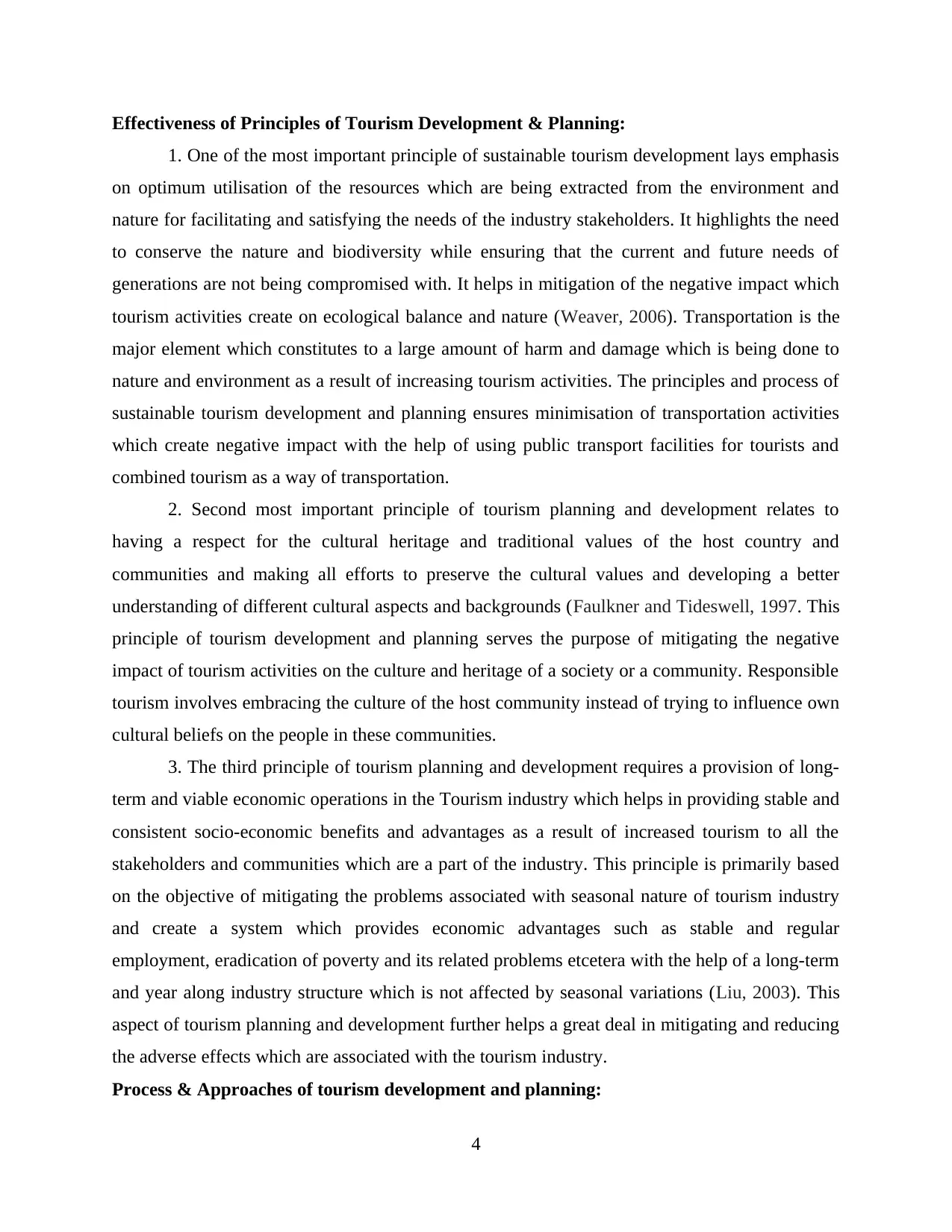
Effectiveness of Principles of Tourism Development & Planning:
1. One of the most important principle of sustainable tourism development lays emphasis
on optimum utilisation of the resources which are being extracted from the environment and
nature for facilitating and satisfying the needs of the industry stakeholders. It highlights the need
to conserve the nature and biodiversity while ensuring that the current and future needs of
generations are not being compromised with. It helps in mitigation of the negative impact which
tourism activities create on ecological balance and nature (Weaver, 2006). Transportation is the
major element which constitutes to a large amount of harm and damage which is being done to
nature and environment as a result of increasing tourism activities. The principles and process of
sustainable tourism development and planning ensures minimisation of transportation activities
which create negative impact with the help of using public transport facilities for tourists and
combined tourism as a way of transportation.
2. Second most important principle of tourism planning and development relates to
having a respect for the cultural heritage and traditional values of the host country and
communities and making all efforts to preserve the cultural values and developing a better
understanding of different cultural aspects and backgrounds (Faulkner and Tideswell, 1997. This
principle of tourism development and planning serves the purpose of mitigating the negative
impact of tourism activities on the culture and heritage of a society or a community. Responsible
tourism involves embracing the culture of the host community instead of trying to influence own
cultural beliefs on the people in these communities.
3. The third principle of tourism planning and development requires a provision of long-
term and viable economic operations in the Tourism industry which helps in providing stable and
consistent socio-economic benefits and advantages as a result of increased tourism to all the
stakeholders and communities which are a part of the industry. This principle is primarily based
on the objective of mitigating the problems associated with seasonal nature of tourism industry
and create a system which provides economic advantages such as stable and regular
employment, eradication of poverty and its related problems etcetera with the help of a long-term
and year along industry structure which is not affected by seasonal variations (Liu, 2003). This
aspect of tourism planning and development further helps a great deal in mitigating and reducing
the adverse effects which are associated with the tourism industry.
Process & Approaches of tourism development and planning:
4
1. One of the most important principle of sustainable tourism development lays emphasis
on optimum utilisation of the resources which are being extracted from the environment and
nature for facilitating and satisfying the needs of the industry stakeholders. It highlights the need
to conserve the nature and biodiversity while ensuring that the current and future needs of
generations are not being compromised with. It helps in mitigation of the negative impact which
tourism activities create on ecological balance and nature (Weaver, 2006). Transportation is the
major element which constitutes to a large amount of harm and damage which is being done to
nature and environment as a result of increasing tourism activities. The principles and process of
sustainable tourism development and planning ensures minimisation of transportation activities
which create negative impact with the help of using public transport facilities for tourists and
combined tourism as a way of transportation.
2. Second most important principle of tourism planning and development relates to
having a respect for the cultural heritage and traditional values of the host country and
communities and making all efforts to preserve the cultural values and developing a better
understanding of different cultural aspects and backgrounds (Faulkner and Tideswell, 1997. This
principle of tourism development and planning serves the purpose of mitigating the negative
impact of tourism activities on the culture and heritage of a society or a community. Responsible
tourism involves embracing the culture of the host community instead of trying to influence own
cultural beliefs on the people in these communities.
3. The third principle of tourism planning and development requires a provision of long-
term and viable economic operations in the Tourism industry which helps in providing stable and
consistent socio-economic benefits and advantages as a result of increased tourism to all the
stakeholders and communities which are a part of the industry. This principle is primarily based
on the objective of mitigating the problems associated with seasonal nature of tourism industry
and create a system which provides economic advantages such as stable and regular
employment, eradication of poverty and its related problems etcetera with the help of a long-term
and year along industry structure which is not affected by seasonal variations (Liu, 2003). This
aspect of tourism planning and development further helps a great deal in mitigating and reducing
the adverse effects which are associated with the tourism industry.
Process & Approaches of tourism development and planning:
4
Paraphrase This Document
Need a fresh take? Get an instant paraphrase of this document with our AI Paraphraser

Tourism development and planning is a systematic process which involves a series of steps
or stages which helps a country or an organisation to determine the goals and objectives which
are associated with the development of tourism industry in the country. It involves finding
answers to questions such as why, what and who to have a clarity of thought and establishing a
base which can help in further development and understanding of the tourism planning process
(Ruhanen, Cooper and Fayos-Solá, 2008). Five main steps can be identified in the process of
tourism planning which involves the first stage of background analysis and understanding the
current nature of tourism in the country, in the next step a research is conducted to organise and
obtain data, third step is to determine the goals related to sustainability of tourism, next step is to
determine the gap or the bridge between current and desired scenarios and the last step is to
make a comprehensive plan according to the objectives and bridging requirements. There are
various approaches of tourism development and planning which are being followed by many
tourist destinations and in the due process, many problems and issues are also being faced by the
host communities. For example, community approach of tourism development and planning lays
focus on the engagement of community and society in influencing the process of tourism
planning and development and aspires for an active public participation which can further help in
enhancing the economic livelihood of the people and safeguarding the environmental and
ecological balance and preserving the cultural values. The community approach of tourism
development and planning is being followed by the Government and responsible organisations in
Indonesia which is a country that is highly dependent on tourism industry as a major source of
revenue. The problem which is being faced by the government in developing and engaging the
community in ensuring the sustainability in tourism activities can be related with the
ineffectiveness and inability to communicate the roles and responsibilities various stakeholders
have to play in ensuring sustainable tourism in the country (Amir and et al., 2015). Lack of
effective community support and engagement is the main problem or barrier which is being
faced by Indonesia and without effective participation of the community, it is very difficult for
the country to manage sustainability in tourism spread at such a large scale. Similarly,
environmental approach of Tourism planning and development is being followed by the
Australian Government which involves minimising the negative impact on nature and
environment as a result of increase in tourism activities in the country. The country has been
facing some serious problems of environmental degradation and climate change which is making
5
or stages which helps a country or an organisation to determine the goals and objectives which
are associated with the development of tourism industry in the country. It involves finding
answers to questions such as why, what and who to have a clarity of thought and establishing a
base which can help in further development and understanding of the tourism planning process
(Ruhanen, Cooper and Fayos-Solá, 2008). Five main steps can be identified in the process of
tourism planning which involves the first stage of background analysis and understanding the
current nature of tourism in the country, in the next step a research is conducted to organise and
obtain data, third step is to determine the goals related to sustainability of tourism, next step is to
determine the gap or the bridge between current and desired scenarios and the last step is to
make a comprehensive plan according to the objectives and bridging requirements. There are
various approaches of tourism development and planning which are being followed by many
tourist destinations and in the due process, many problems and issues are also being faced by the
host communities. For example, community approach of tourism development and planning lays
focus on the engagement of community and society in influencing the process of tourism
planning and development and aspires for an active public participation which can further help in
enhancing the economic livelihood of the people and safeguarding the environmental and
ecological balance and preserving the cultural values. The community approach of tourism
development and planning is being followed by the Government and responsible organisations in
Indonesia which is a country that is highly dependent on tourism industry as a major source of
revenue. The problem which is being faced by the government in developing and engaging the
community in ensuring the sustainability in tourism activities can be related with the
ineffectiveness and inability to communicate the roles and responsibilities various stakeholders
have to play in ensuring sustainable tourism in the country (Amir and et al., 2015). Lack of
effective community support and engagement is the main problem or barrier which is being
faced by Indonesia and without effective participation of the community, it is very difficult for
the country to manage sustainability in tourism spread at such a large scale. Similarly,
environmental approach of Tourism planning and development is being followed by the
Australian Government which involves minimising the negative impact on nature and
environment as a result of increase in tourism activities in the country. The country has been
facing some serious problems of environmental degradation and climate change which is making
5
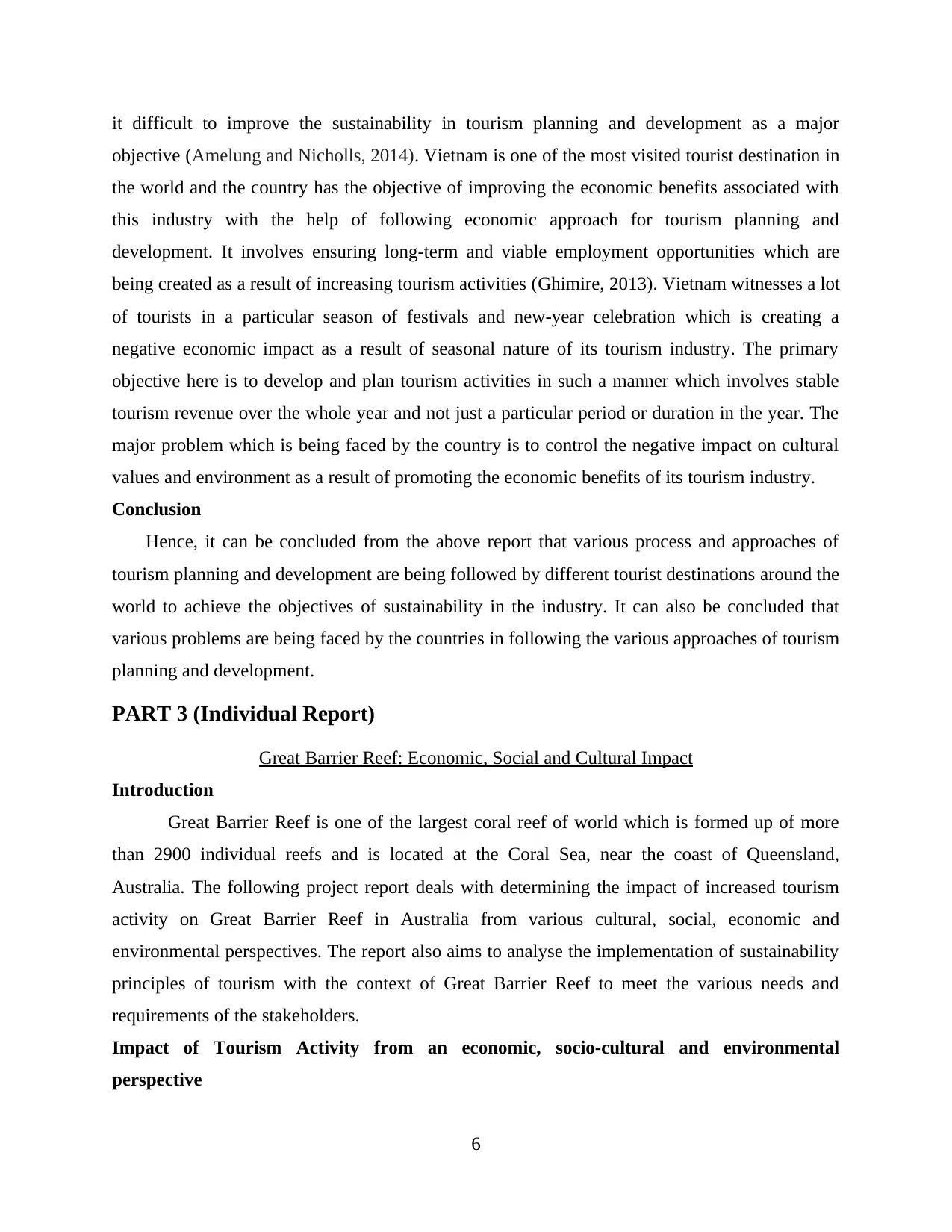
it difficult to improve the sustainability in tourism planning and development as a major
objective (Amelung and Nicholls, 2014). Vietnam is one of the most visited tourist destination in
the world and the country has the objective of improving the economic benefits associated with
this industry with the help of following economic approach for tourism planning and
development. It involves ensuring long-term and viable employment opportunities which are
being created as a result of increasing tourism activities (Ghimire, 2013). Vietnam witnesses a lot
of tourists in a particular season of festivals and new-year celebration which is creating a
negative economic impact as a result of seasonal nature of its tourism industry. The primary
objective here is to develop and plan tourism activities in such a manner which involves stable
tourism revenue over the whole year and not just a particular period or duration in the year. The
major problem which is being faced by the country is to control the negative impact on cultural
values and environment as a result of promoting the economic benefits of its tourism industry.
Conclusion
Hence, it can be concluded from the above report that various process and approaches of
tourism planning and development are being followed by different tourist destinations around the
world to achieve the objectives of sustainability in the industry. It can also be concluded that
various problems are being faced by the countries in following the various approaches of tourism
planning and development.
PART 3 (Individual Report)
Great Barrier Reef: Economic, Social and Cultural Impact
Introduction
Great Barrier Reef is one of the largest coral reef of world which is formed up of more
than 2900 individual reefs and is located at the Coral Sea, near the coast of Queensland,
Australia. The following project report deals with determining the impact of increased tourism
activity on Great Barrier Reef in Australia from various cultural, social, economic and
environmental perspectives. The report also aims to analyse the implementation of sustainability
principles of tourism with the context of Great Barrier Reef to meet the various needs and
requirements of the stakeholders.
Impact of Tourism Activity from an economic, socio-cultural and environmental
perspective
6
objective (Amelung and Nicholls, 2014). Vietnam is one of the most visited tourist destination in
the world and the country has the objective of improving the economic benefits associated with
this industry with the help of following economic approach for tourism planning and
development. It involves ensuring long-term and viable employment opportunities which are
being created as a result of increasing tourism activities (Ghimire, 2013). Vietnam witnesses a lot
of tourists in a particular season of festivals and new-year celebration which is creating a
negative economic impact as a result of seasonal nature of its tourism industry. The primary
objective here is to develop and plan tourism activities in such a manner which involves stable
tourism revenue over the whole year and not just a particular period or duration in the year. The
major problem which is being faced by the country is to control the negative impact on cultural
values and environment as a result of promoting the economic benefits of its tourism industry.
Conclusion
Hence, it can be concluded from the above report that various process and approaches of
tourism planning and development are being followed by different tourist destinations around the
world to achieve the objectives of sustainability in the industry. It can also be concluded that
various problems are being faced by the countries in following the various approaches of tourism
planning and development.
PART 3 (Individual Report)
Great Barrier Reef: Economic, Social and Cultural Impact
Introduction
Great Barrier Reef is one of the largest coral reef of world which is formed up of more
than 2900 individual reefs and is located at the Coral Sea, near the coast of Queensland,
Australia. The following project report deals with determining the impact of increased tourism
activity on Great Barrier Reef in Australia from various cultural, social, economic and
environmental perspectives. The report also aims to analyse the implementation of sustainability
principles of tourism with the context of Great Barrier Reef to meet the various needs and
requirements of the stakeholders.
Impact of Tourism Activity from an economic, socio-cultural and environmental
perspective
6
⊘ This is a preview!⊘
Do you want full access?
Subscribe today to unlock all pages.

Trusted by 1+ million students worldwide
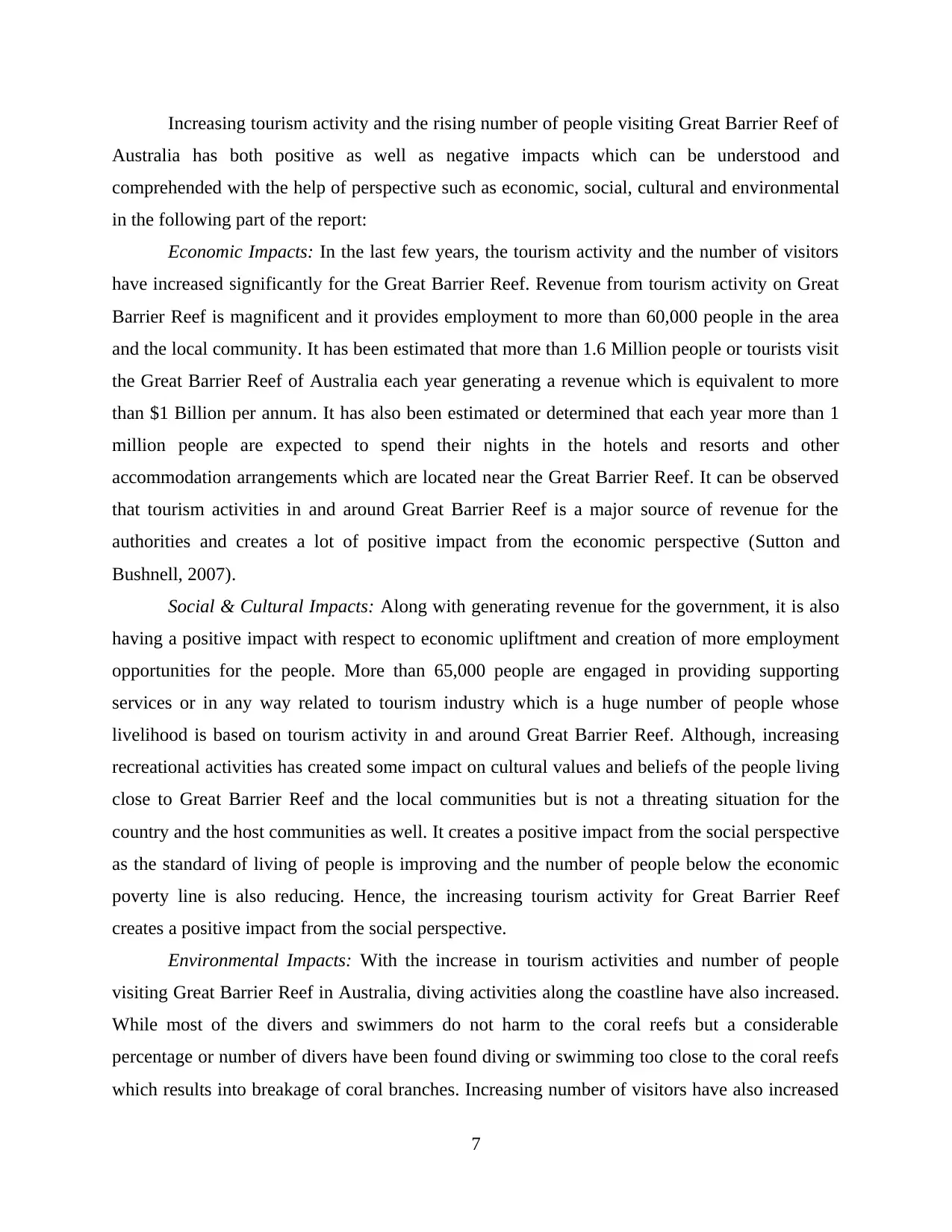
Increasing tourism activity and the rising number of people visiting Great Barrier Reef of
Australia has both positive as well as negative impacts which can be understood and
comprehended with the help of perspective such as economic, social, cultural and environmental
in the following part of the report:
Economic Impacts: In the last few years, the tourism activity and the number of visitors
have increased significantly for the Great Barrier Reef. Revenue from tourism activity on Great
Barrier Reef is magnificent and it provides employment to more than 60,000 people in the area
and the local community. It has been estimated that more than 1.6 Million people or tourists visit
the Great Barrier Reef of Australia each year generating a revenue which is equivalent to more
than $1 Billion per annum. It has also been estimated or determined that each year more than 1
million people are expected to spend their nights in the hotels and resorts and other
accommodation arrangements which are located near the Great Barrier Reef. It can be observed
that tourism activities in and around Great Barrier Reef is a major source of revenue for the
authorities and creates a lot of positive impact from the economic perspective (Sutton and
Bushnell, 2007).
Social & Cultural Impacts: Along with generating revenue for the government, it is also
having a positive impact with respect to economic upliftment and creation of more employment
opportunities for the people. More than 65,000 people are engaged in providing supporting
services or in any way related to tourism industry which is a huge number of people whose
livelihood is based on tourism activity in and around Great Barrier Reef. Although, increasing
recreational activities has created some impact on cultural values and beliefs of the people living
close to Great Barrier Reef and the local communities but is not a threating situation for the
country and the host communities as well. It creates a positive impact from the social perspective
as the standard of living of people is improving and the number of people below the economic
poverty line is also reducing. Hence, the increasing tourism activity for Great Barrier Reef
creates a positive impact from the social perspective.
Environmental Impacts: With the increase in tourism activities and number of people
visiting Great Barrier Reef in Australia, diving activities along the coastline have also increased.
While most of the divers and swimmers do not harm to the coral reefs but a considerable
percentage or number of divers have been found diving or swimming too close to the coral reefs
which results into breakage of coral branches. Increasing number of visitors have also increased
7
Australia has both positive as well as negative impacts which can be understood and
comprehended with the help of perspective such as economic, social, cultural and environmental
in the following part of the report:
Economic Impacts: In the last few years, the tourism activity and the number of visitors
have increased significantly for the Great Barrier Reef. Revenue from tourism activity on Great
Barrier Reef is magnificent and it provides employment to more than 60,000 people in the area
and the local community. It has been estimated that more than 1.6 Million people or tourists visit
the Great Barrier Reef of Australia each year generating a revenue which is equivalent to more
than $1 Billion per annum. It has also been estimated or determined that each year more than 1
million people are expected to spend their nights in the hotels and resorts and other
accommodation arrangements which are located near the Great Barrier Reef. It can be observed
that tourism activities in and around Great Barrier Reef is a major source of revenue for the
authorities and creates a lot of positive impact from the economic perspective (Sutton and
Bushnell, 2007).
Social & Cultural Impacts: Along with generating revenue for the government, it is also
having a positive impact with respect to economic upliftment and creation of more employment
opportunities for the people. More than 65,000 people are engaged in providing supporting
services or in any way related to tourism industry which is a huge number of people whose
livelihood is based on tourism activity in and around Great Barrier Reef. Although, increasing
recreational activities has created some impact on cultural values and beliefs of the people living
close to Great Barrier Reef and the local communities but is not a threating situation for the
country and the host communities as well. It creates a positive impact from the social perspective
as the standard of living of people is improving and the number of people below the economic
poverty line is also reducing. Hence, the increasing tourism activity for Great Barrier Reef
creates a positive impact from the social perspective.
Environmental Impacts: With the increase in tourism activities and number of people
visiting Great Barrier Reef in Australia, diving activities along the coastline have also increased.
While most of the divers and swimmers do not harm to the coral reefs but a considerable
percentage or number of divers have been found diving or swimming too close to the coral reefs
which results into breakage of coral branches. Increasing number of visitors have also increased
7
Paraphrase This Document
Need a fresh take? Get an instant paraphrase of this document with our AI Paraphraser

the pollution levels around the area which is not desirable by any country. People are found
littering the coastal lines and discharging the waste materials and sewages near the coasts which
pollute the coral reefs. Australia is a country which is dealing with the problem and harmful
effects of climate change for a long period and while increasing tourism activity around Great
Barrier Reef creates a positive economic and social impact but it certainly increases the problem
associated with climate change and environmental degradation further for the country (Johnson,
Marshall and Authority, 2007).
Implementation of Principles of Tourism to meet stakeholder needs and requirements
With a motive of protecting the Great Barrier Reef for the present generations as well as
generations to come in the future, Australian government started implementing the principles of
sustainability to meet the various needs and requirements of the stakeholders. Principles of
Sustainable Tourism such as optimum utilisation of the resources which are being extracted from
the environment as a support to tourism activities and maintaining the long term benefits and
stable employment for the people engaged in the tourism activity are being implemented to meet
the needs and requirements of various stakeholders. The Government of Australia has partnered
with private sector industries and corporations and is investing an amount equivalent to
approximately $200 Million for the protection and development of the health and condition of
the reefs (Authority, 2014). With the help of this investment in maintaining the condition of
Great Barrier Reef and implementing the principle of sustainability, needs and requirements of
stakeholders such as people who are engaged in employment with the tourism activity and whose
livelihoods depend on the extent of tourism activity on the reefs are being satisfied. It ensures the
long-term viability of the tourist attraction and avoids any harm which can hinder the
sustainability of the tourist attraction. As a measure to protect the impact which is being created
on the environment and satisfy the needs of stakeholders which involves caretakers of the
environment and preventing the country from adverse effects of climate change, a monitoring
system has been implemented by the government to evaluate the impact of these activities on the
nature and it also involves training and education of the people who are closely involved in this.
Educational programs and penalties have been established for littering and related problems.
Diving training programs and limit of diving per year have been set-up. Any kind of feeding
activities requires permission from the government and the visit to key breeding sites of turtles is
also provisional.. Water quality management programs have been implemented to maintain
8
littering the coastal lines and discharging the waste materials and sewages near the coasts which
pollute the coral reefs. Australia is a country which is dealing with the problem and harmful
effects of climate change for a long period and while increasing tourism activity around Great
Barrier Reef creates a positive economic and social impact but it certainly increases the problem
associated with climate change and environmental degradation further for the country (Johnson,
Marshall and Authority, 2007).
Implementation of Principles of Tourism to meet stakeholder needs and requirements
With a motive of protecting the Great Barrier Reef for the present generations as well as
generations to come in the future, Australian government started implementing the principles of
sustainability to meet the various needs and requirements of the stakeholders. Principles of
Sustainable Tourism such as optimum utilisation of the resources which are being extracted from
the environment as a support to tourism activities and maintaining the long term benefits and
stable employment for the people engaged in the tourism activity are being implemented to meet
the needs and requirements of various stakeholders. The Government of Australia has partnered
with private sector industries and corporations and is investing an amount equivalent to
approximately $200 Million for the protection and development of the health and condition of
the reefs (Authority, 2014). With the help of this investment in maintaining the condition of
Great Barrier Reef and implementing the principle of sustainability, needs and requirements of
stakeholders such as people who are engaged in employment with the tourism activity and whose
livelihoods depend on the extent of tourism activity on the reefs are being satisfied. It ensures the
long-term viability of the tourist attraction and avoids any harm which can hinder the
sustainability of the tourist attraction. As a measure to protect the impact which is being created
on the environment and satisfy the needs of stakeholders which involves caretakers of the
environment and preventing the country from adverse effects of climate change, a monitoring
system has been implemented by the government to evaluate the impact of these activities on the
nature and it also involves training and education of the people who are closely involved in this.
Educational programs and penalties have been established for littering and related problems.
Diving training programs and limit of diving per year have been set-up. Any kind of feeding
activities requires permission from the government and the visit to key breeding sites of turtles is
also provisional.. Water quality management programs have been implemented to maintain
8
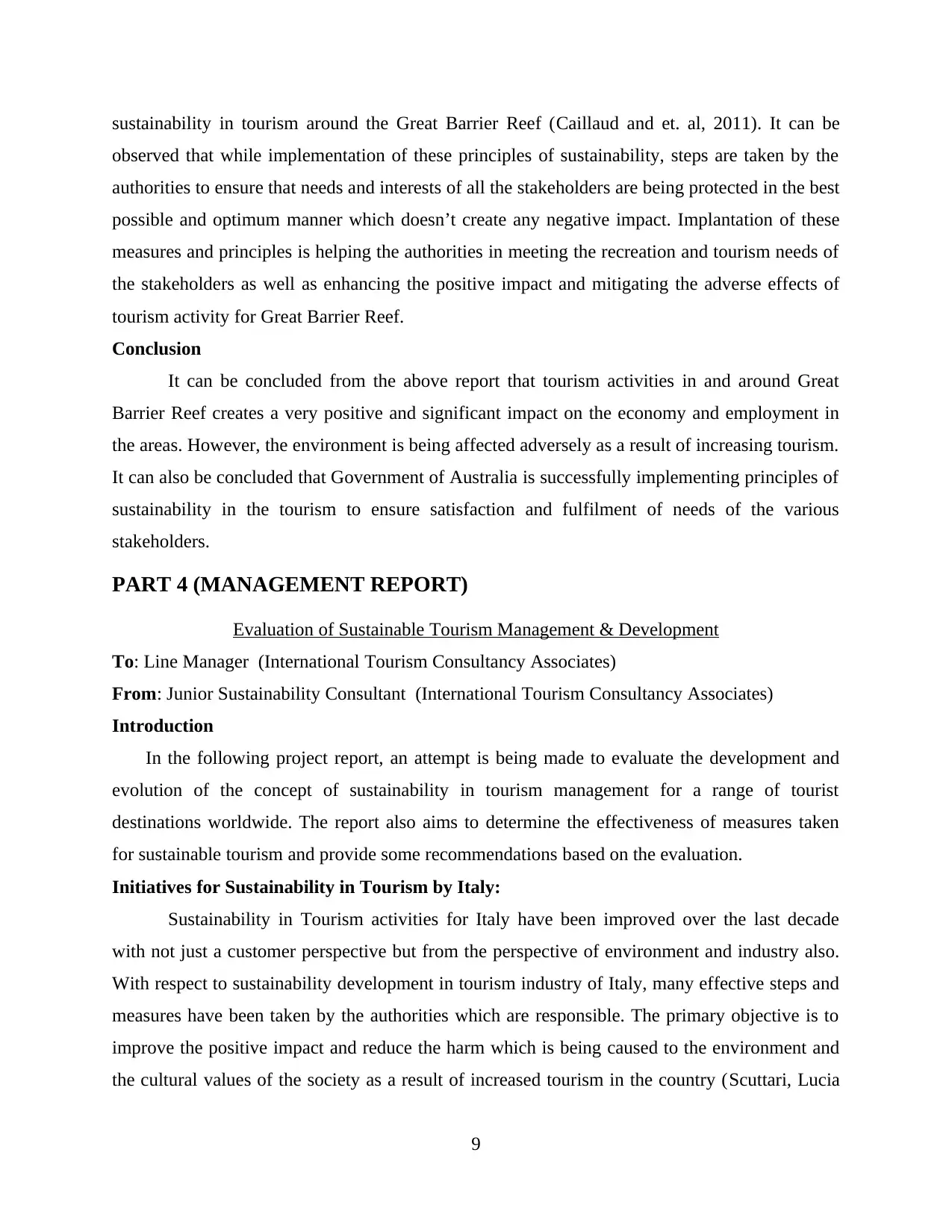
sustainability in tourism around the Great Barrier Reef (Caillaud and et. al, 2011). It can be
observed that while implementation of these principles of sustainability, steps are taken by the
authorities to ensure that needs and interests of all the stakeholders are being protected in the best
possible and optimum manner which doesn’t create any negative impact. Implantation of these
measures and principles is helping the authorities in meeting the recreation and tourism needs of
the stakeholders as well as enhancing the positive impact and mitigating the adverse effects of
tourism activity for Great Barrier Reef.
Conclusion
It can be concluded from the above report that tourism activities in and around Great
Barrier Reef creates a very positive and significant impact on the economy and employment in
the areas. However, the environment is being affected adversely as a result of increasing tourism.
It can also be concluded that Government of Australia is successfully implementing principles of
sustainability in the tourism to ensure satisfaction and fulfilment of needs of the various
stakeholders.
PART 4 (MANAGEMENT REPORT)
Evaluation of Sustainable Tourism Management & Development
To: Line Manager (International Tourism Consultancy Associates)
From: Junior Sustainability Consultant (International Tourism Consultancy Associates)
Introduction
In the following project report, an attempt is being made to evaluate the development and
evolution of the concept of sustainability in tourism management for a range of tourist
destinations worldwide. The report also aims to determine the effectiveness of measures taken
for sustainable tourism and provide some recommendations based on the evaluation.
Initiatives for Sustainability in Tourism by Italy:
Sustainability in Tourism activities for Italy have been improved over the last decade
with not just a customer perspective but from the perspective of environment and industry also.
With respect to sustainability development in tourism industry of Italy, many effective steps and
measures have been taken by the authorities which are responsible. The primary objective is to
improve the positive impact and reduce the harm which is being caused to the environment and
the cultural values of the society as a result of increased tourism in the country (Scuttari, Lucia
9
observed that while implementation of these principles of sustainability, steps are taken by the
authorities to ensure that needs and interests of all the stakeholders are being protected in the best
possible and optimum manner which doesn’t create any negative impact. Implantation of these
measures and principles is helping the authorities in meeting the recreation and tourism needs of
the stakeholders as well as enhancing the positive impact and mitigating the adverse effects of
tourism activity for Great Barrier Reef.
Conclusion
It can be concluded from the above report that tourism activities in and around Great
Barrier Reef creates a very positive and significant impact on the economy and employment in
the areas. However, the environment is being affected adversely as a result of increasing tourism.
It can also be concluded that Government of Australia is successfully implementing principles of
sustainability in the tourism to ensure satisfaction and fulfilment of needs of the various
stakeholders.
PART 4 (MANAGEMENT REPORT)
Evaluation of Sustainable Tourism Management & Development
To: Line Manager (International Tourism Consultancy Associates)
From: Junior Sustainability Consultant (International Tourism Consultancy Associates)
Introduction
In the following project report, an attempt is being made to evaluate the development and
evolution of the concept of sustainability in tourism management for a range of tourist
destinations worldwide. The report also aims to determine the effectiveness of measures taken
for sustainable tourism and provide some recommendations based on the evaluation.
Initiatives for Sustainability in Tourism by Italy:
Sustainability in Tourism activities for Italy have been improved over the last decade
with not just a customer perspective but from the perspective of environment and industry also.
With respect to sustainability development in tourism industry of Italy, many effective steps and
measures have been taken by the authorities which are responsible. The primary objective is to
improve the positive impact and reduce the harm which is being caused to the environment and
the cultural values of the society as a result of increased tourism in the country (Scuttari, Lucia
9
⊘ This is a preview!⊘
Do you want full access?
Subscribe today to unlock all pages.

Trusted by 1+ million students worldwide
1 out of 16
Related Documents
Your All-in-One AI-Powered Toolkit for Academic Success.
+13062052269
info@desklib.com
Available 24*7 on WhatsApp / Email
![[object Object]](/_next/static/media/star-bottom.7253800d.svg)
Unlock your academic potential
Copyright © 2020–2025 A2Z Services. All Rights Reserved. Developed and managed by ZUCOL.




